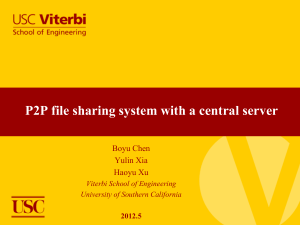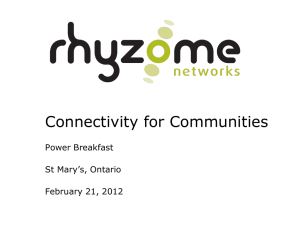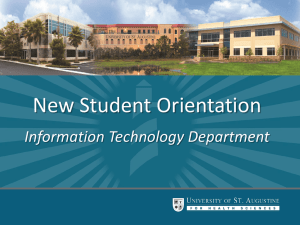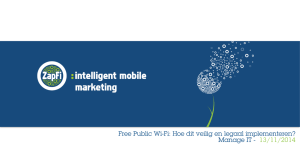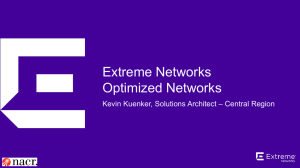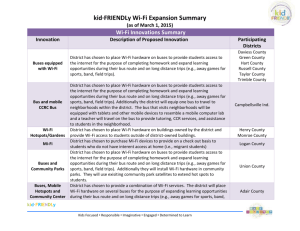techinfra1-23-13 - Piedmont Unified School District
advertisement
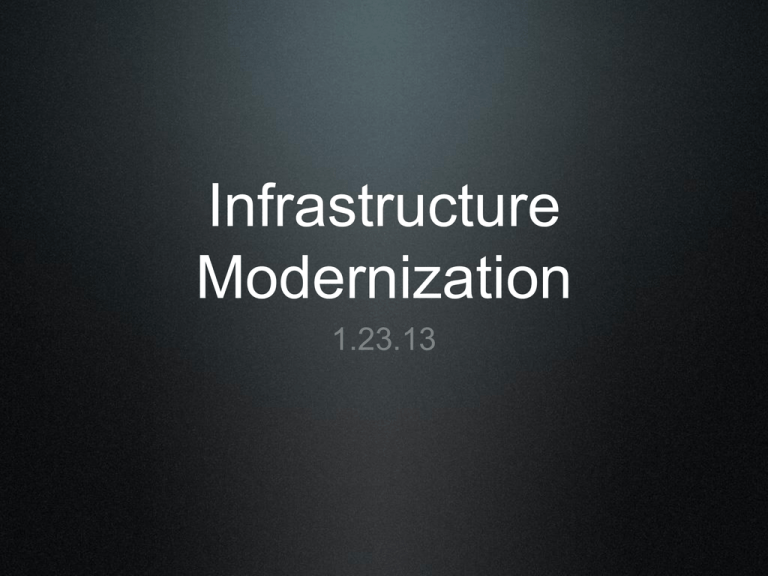
Infrastructure Modernization 1.23.13 Overview • What is technology infrastructure? • Why should we invest in it? • What are current best practices/recommendations? • Where do we stand? • What possible improvements will position us for the next 10-15 years? Tech and Infrastructure http://www.csudh.edu/actech/smartc/images/laptop1%20(3).JPG • tech “in front” of the plug Tech and Infrastructure http://farm8.staticflickr.com/7185/6899056705_5c81ac71e8_z.jpg • the infrastructure behind the plug • managed by our electrician, Bill Parsons tonight we will be discussing improvements to the physical plan. improvements that students and teachers won’t have direct contact with... So why have Instructional Technology Coordinator present the projects? Understand the impact of project upon many of the Board Goals •#1 Adapt and Improve Educational Program and Delivery •#2 Support Professional Growth and Instructional Effectiveness •#3 Provide Safe Learning Environment •#4 Foster a Dynamic Learning Community •#6 Invest in/Preserve Facilities and Infrastructure incredible impact on student learning, instruction and safety. Completed Projects’ Infrastructure • modern, flexible bell and http://www.piedmontcivic.org/wpcontent/uploads/2010/08/city-photo-havensname2.jpg paging systems • intercoms to classrooms • current standards and best practices for network wiring, cables, management http://o1.aolcdn.com/dimsshared/dims3/PATCH/resize/600x450/http://hssprod.hss.aol.com/hss/storage/patch/5b58c01889744ca 1f6751e6cbe06b7a5 • incredible flexibility in infrastructure due to power over ethernet http://livingnewdeal.berkeley.edu/projects/beachelementary-school-piedmont-ca/ Where do PHS, MHS, DO and PMS stand? • old (original?) public • • • • address systems. no way to alert all schools because of disparate systems network infrastructure 25+ years old and failing in some situations one network connection per room vs 10 at elementaries older switches can’t supply power or provide adequate speed photo S. Griffin photo S. Griffin Guiding Principles • can’t future-proof, but can follow best practices • look to solutions that permit adaptability/flexibility • solutions need to be sustainable • approach infrastructure not for infrastructure sake, but with educational goals and mission in mind. • Ask not what teachers can do with technology, but what technology can do for our teachers. Best Practices • talked with many experts and spent most of Fall information gathering. • Alameda County Office of Education and regional leaders • California Educational Technology Professionals • • Association Conference and Computer Using Educators conference our outside technical support MarinIT various vendors, other professionals in the field of educational technology. • lots of geek-speak, but similar recommendations/best practices congealed around “vision” needs developed internally What do schools need to support learning? Capacity for digital and mobile learning •connect buildings •modern wi-fi access point in every classroom •100mb+ bandwidth to internet http://www.educationsuperhighway.org/about.html Why access to internet? • 1 million in holdings in PUSD libraries, but infinitely more resources available on internet Why access to internet? • the district has been moving to cloud based solutions Why access to internet? • Common Core Standards http://www.corestandards.org/resources Why access to internet? • Teach Digital Literacy- Protecting Children in the 21st Century Act Why access to internet? • mobile learning- human knowledge in the palm of your hand Why access to internet? • engagement • authentic • global • 21st century skills- collaboration, communication, creativity, citizenship, cognition http://web.jc-schools.net/dittmerm/library-media-program/ What infrastructure do we need to support digital learning? • connect buildings • modern wi-fi access point in every classroom • 100mb+ bandwidth to internet • all sites aren’t connected, safety consideration? • old wi-fi to provide coverage, not density • no wiring exists to support wi-fi and other infrastructure improvements at PHS, MHS, PMS • can’t use all of our 100mb as a key part of our networ can only handle 87mb at its peak and sustains closer to 55mb Identifying Needs and Solutions • • • • • • • cabling switching building connections modern wi-fi safety solutions remove “core” network limitations logical network design and servers connect at min 100mb add wi-fi (and other services) connect cables to building level switch, and buildings with fiber to DO and buildings with fiber to DO switches/routers connect buildings to local systems and the internet cabling to classrooms not to exceed $420,000 switching and routing not to exceed $600,000 • other projects’ scope effects number of cables, switches, racks to hold them etc. • adds connections for wi-fi and paging in each room using current standard wires (same as at elementaries) • connects main campus buildings with current standard fiber • includes necessary core network equipment so that we get 100mb+ bandwidth • new switches provide power and are higher speed. ubiquitous wi-fi not to exceed $170,000 • 180 wi-fi access points • 802.11n standard • 5x faster than current wi-fi • handles higher density • install 1 per classroom at ALL* campuses • provide wi-fi in outdoor learning areas and outdoor emergency staging areas • *needs network cable and power providing switches at PHS, MHS, DO and PMS School P/A Systems for PHS, MHS, PMS $175,000-$593,000 Match elementary schools: $593,000* • bell system, classroom two-way paging/intercom, ceiling speakers, back-up power, new video projectors integrated in system, video mutes under announcements. System without video upgrade: $400,000* • bells, classroom two-way paging/intercom, ceiling speakers, back-up power, “video ready” System without classroom use of speakers: $350,000* • bells, two-way paging, back-up power, no provisions for classroom use of speakers, no path to integrated video One-way paging: $175,000 • bells, paging into rooms, back-up power only *need cabling and switches District Directory/Server Restructuring $125,000-$250,000 Access managed by our directory “gatekeeper” • currently directory system overly complex • creates need for multiple servers to maintain, power, back• up, support and service and purchase can’t leverage it to tie into other systems like IC, Google Apps due to complexity Restructure directory: $125,000-$250,000 • • • • “flatten” directory to remove complexity repurpose servers, retiring ones not in use develop back-up systems and disaster recovery plan “virtualize” servers as appropriate Create easier to manage, secure, more resilient network with less overhead, power consumption, and complexity. Wi-fi access will be based on name/password in directory. À la carte A few projects that are not as dependent on others, or not as crucial to the core educational and/or safety objectives. Phone System: $125,000 ROI 2.5 yrs Current system old with high 3rd party support costs$48,000 yr upgrade to current version with increased feature set results in $2,500 yr in support costs provides path to more voice-over-ip in future and can reuse analog phones now. Fiber connection to Havens and/or Beach: $20,000-$250,000 Currently leasing lines from AT&T to connect Havens and Beach to core campus at fraction of core campus speeds at current cost of $18,000/yr investigating solutions to connect one or both schools to main campus on district owned equipment, increasing service levels and ongoing costs. solutions currently under exploration under microwave, above ground and below ground fiber. Emergency diesel generator: $20,000-$40,000 Install emergency power system to District Office building to power data center, core switch/router, student information system in power outage. Investment in Plant • projects are behind the walls improvements • continuing on best practices implemented in seismic renovations • can’t future-proof but can try to create a more sustainable, manageable, flexible, adaptive set of systems to get us 10-15 years Investment in Plant • allow us to meet opportunities and obligations • online high stakes testing • mobile learning • internet resources • increased safety systems • communication systems for mobile worlds

